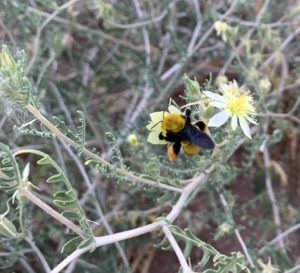April – Morrison’s Bumble Bee
Scientific name: Bombus morrisoni
Common name: Morrison’s Bumble Bee

Family: Apidae
It’s April and spring is in the air! As plants begin to reemerge from the soil and those early bloomers start to bud, this is the time of year you are likely able to spot queen bumble bees emerging from hibernation in the Santa Fe area. One bumble bee species you can encounter in Santa Fe is Morrison’s bumble bee (Bombus morrisoni), a species whose range covers most of the Western United States. With luxurious yellow hair covering most of the thorax and all but the end of the abdomen, this bumble bee is relatively easy to distinguish from other common Santa Fe bumble bees. Morrison’s bumble bee often has a very faint dot on the thorax between the wings.
Bumble bees have a unique life cycle where in spring, female queen bumble bees end hibernation and emerge from under leaf litter, rocks, or other insulated, undisturbed places where they spent the winter. These newly awakened queens must find food to fuel their flight and search for a location to establish a nest, typically in abandoned rodent burrows or other similar small cavities in the ground. They lay eggs in this nest and forage for pollen to feed their first round of offspring, all of which are female and non-reproductive worker bees. Once those workers are active flying adults, they start foraging for food to sustain the growing colony and the queen stays in the nest to lay more eggs. You can observe this transition when the few, massive queens are replaced by much smaller, more abundant worker bumble bees as spring turns into summer. You can learn more about bumble bees here.

While frequently encountered in Santa Fe, Morrison’s bumble bee is disappearing across parts of its range with declines in relative abundance by 74% and persistence in 66% less area than historically reported. The Xerces Society recently petitioned to list the Morrison’s bumble bee as an endangered species under the federal Endangered Species Act to reduce the risk of extinction for this important pollinator. As a stronghold in this species’ shrinking range across the western US, Santa Fe is an important conservation area for these bumble bees and offers residents and visitors an exciting opportunity to view and protect this imperiled species.

To support Morrison’s bumble bees, we need to grow and abundance of flowering plants that offer blooms from spring to fall to feed queens emerging from hibernation, large colonies in summer, and new queens bulking up for hibernation. We also need to protect nests during the growing season and provide undisturbed cover during winter for hibernating queens. This habitat needs to be protected from pesticide use to keep populations healthy and thriving, which will benefit many other valuable insect species in our landscapes.
Check out Xerces pollinator plant lists to find out what you can grow to feed pollinators!
Article and Images by Kaitlin Haase
image 1: Bombus morrisoni, Helianthus annuus
image 2: Bombus morrisoni, Mentzelia multiflora
image 3: Bombus morrisoni, Cleome serrulata


